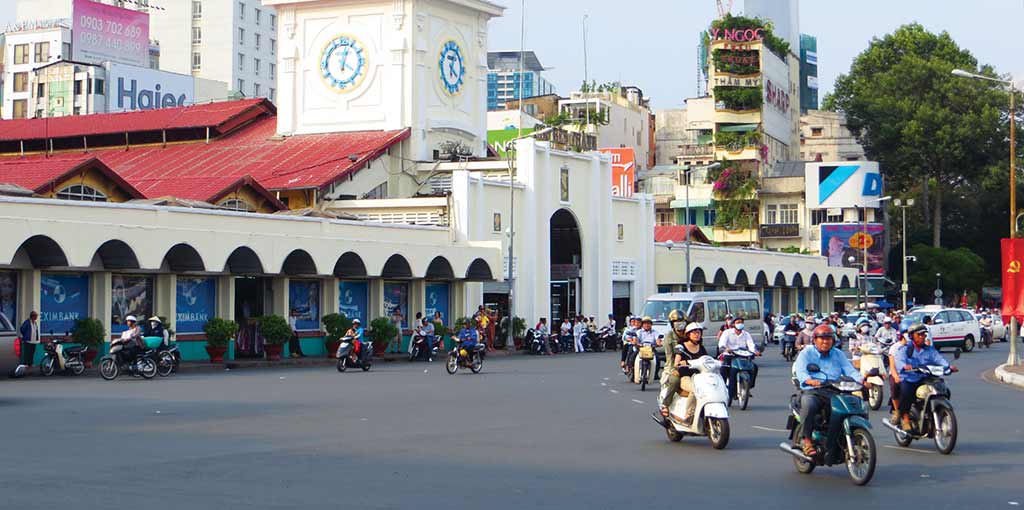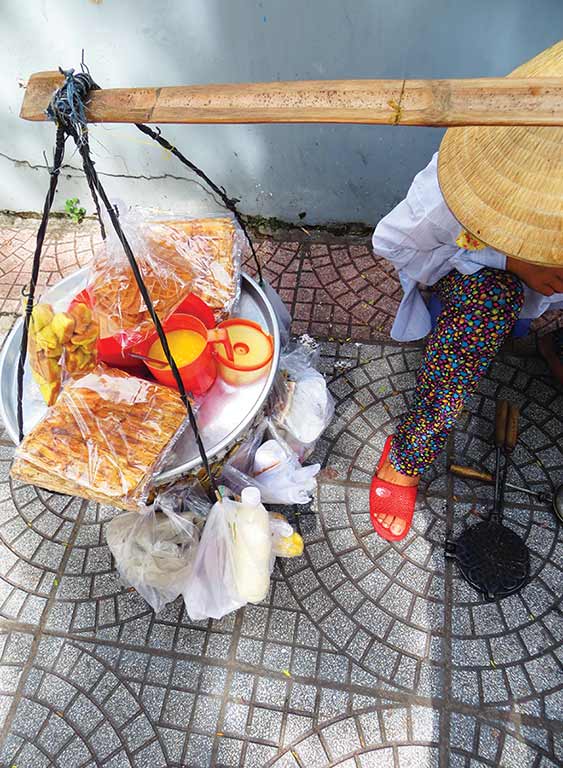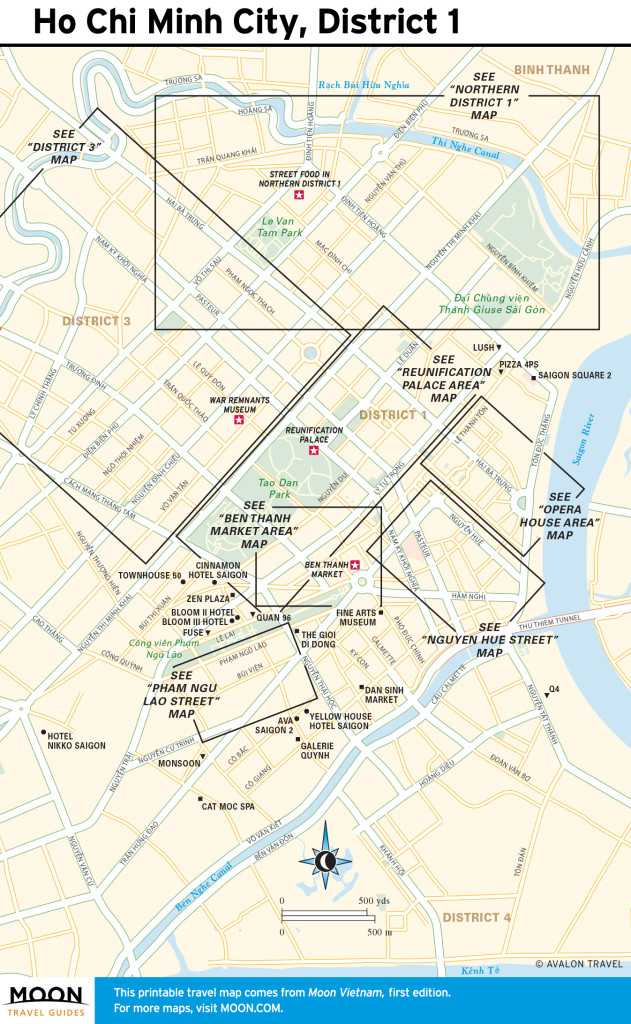Get anywhere near the flashing neon lights, full-throttle traffic, sardined houses, and soaring commercial towers of the country’s southern hub and it becomes clear why Ho Chi Minh City (HCMC) is the future of Vietnam. Indisputably the economic heart of the nation, this fast-paced, ever-expanding behemoth has charged fearlessly—and sometimes recklessly—into the 21st century, carrying along a diverse and multifaceted population, a keen business acumen, and an irrepressible spirit.

Ben Thanh Market in Ho Chi Minh City. Photo © Dana Filek-Gibson.
Along with the madness of the city comes an intricate and fascinating history that announces itself time and again in the city’s eclectic architecture and multifaceted cuisine.Shackled by heavy-handed governmental policies after the Vietnam War, HCMC hit the ground running in the mid-1980s, as the nation’s doi moi economic reforms flung open the door to international business and trade. A decade of pent-up energy was unleashed, sending the city on a frantic, determined mission to become Vietnam’s cosmopolitan leader. HCMC—still known to locals as Saigon—packs all of southern Vietnam’s best food, art, culture, and diversity into the jumbled houses and narrow alleyways of the country’s most ambitious metropolis.Settled on the sticky, humid, pancake-flat marshland just east of the Mekong Delta, the city began only a few centuries ago but has exploded in population over the past two decades. Even today, immigrants travel from near and far, hoping to make a home and a living amid the bustle of Vietnam’s largest city. Government statistics put the urban population at around 7.5 million residents and counting, but this number hardly seems enough when you sit bumper-to-bumper in midday traffic or squeeze onto a tiny patch of sidewalk for a nighttime ca phe bet (streetside coffee). Others estimate the actual population as much higher, from just north of 8 million to as great as 10 million people. Whatever the number, HCMC shows no signs of stopping. Already, outlying districts are swallowing up nearby towns like Di An and Bien Hoa, and the population of the greater metropolitan area is expected to grow to as many as nine million by official statistics in 2025.
From a traveler’s perspective, the city is both a blessing and a curse: HCMC provides a more lively, chaotic, and occasionally dangerous atmosphere than the sleepy towns of the coast. Along with the madness of the city comes an intricate and fascinating history that announces itself time and again in the city’s eclectic architecture and multifaceted cuisine. Stroll along the wide boulevards of downtown District 1, where opulent colonial-era buildings stand, or hang onto your helmet as you race down the narrow streets of Chinatown on the back of a motorbike, defying the laws of physics as you weave through traffic.

A street vendor in District 1. Photo © Dana Filek-Gibson.
Hidden farther down the city’s many alleys is another world altogether, quiet and reserved, where children play on empty sidewalks and old women sit sentinel, fanning themselves in the afternoon heat. For as many modern complexes as the city has acquired in recent years, remnants of an earlier time remain in the aging facades of historical buildings and the one-room restaurants that continue to turn a profit, even as high-end eateries go into business next door. HCMC is a sensory overload. Step into the chaos with optimism, and you will be rewarded by life in Vietnam’s largest city.
Though the jumble of traffic and mismatched buildings can seem infinite, the city’s downtown area is small. Most of the city’s major sights and activities can be covered within four or five days, as attractions tend to be concentrated around Districts 1 and 5.

Ho Chi Minh City, District 1
Do your sightseeing in the morning to avoid the heat, especially if you’re visiting pagodas and other non-air-conditioned places. Afternoons are great for activities, eating, and taking in the buzz of the city. Though businesses stay open at lunchtime, many Vietnamese take siesta around noon, particularly those working at museums and government-run buildings, so avoid these places at midday. Once the sun goes down, street vendors set up along sidewalks, restaurants open, and tiny roadside stalls sling beer and do nhau (drinking food). The heat also lets up, making the evening a perfect time to wander through a night market, grab a bite to eat, or delve into the city’s nightlife.
Set aside a day or two to escape the downtown area and pay a visit to the Cu Chi Tunnels or Tay Ninh’s mammoth Cao Dai temple.
You should have no trouble finding English speakers downtown, though you may occasionally have to rely on the pick-and-point method. When heading out for the day, grab a business card from your hotel or jot down the address of wherever you’re headed: While most taxi and xe om (motorbike taxi) drivers know the city’s major landmarks, it pays to have the address and district on hand for lesser-known locations.
The biggest holiday of the year is Tet (Lunar New Year, late Jan.-mid-Feb.), a day when everyone in Vietnam returns to their hometown to celebrate. During this time, HCMC is virtually a ghost town. Most streets are empty and businesses deserted. Many services are not available or if they are prices go up considerably to compensate.
Excerpted from the First Edition of Moon Vietnam.